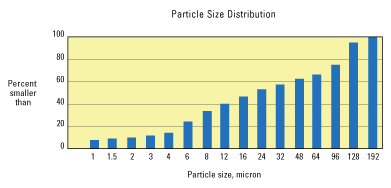1. n. [Drilling Fluids]
The weight, or net volume, of solid particles that fall into each of the various size ranges, given as a percentage of the total solids of all sizes in the sample of interest. Particle size can be determined by sieve analysis, light scattering, passage through an electrically charged orifice, settling rate or other methods. Data are typically shown as a histogram chart with percentage-smaller-than on the y-axis and size ranges on the x-axis. Mud engineers use such data to operate solids-control equipment effectively. Particle-size distributions are used to evaluate bridging materials for drill-in and completion fluids. Barite and hematite samples are examined to ensure performance without excessive wear on equipment and as an API/ISO quality specification.
See related terms: abrasion test, bridging material, mud engineer, sized calcium carbonate, sized salt
